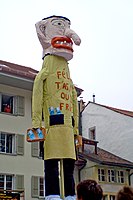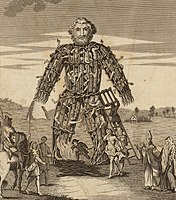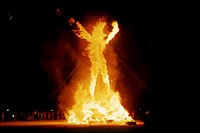Effigy


An effigy is a sculptural representation, often life-size, of a specific person or a prototypical figure.[1] The term is mostly used for the makeshift dummies used for symbolic punishment in political protests and for the figures burned in certain traditions around New Year, Carnival and Easter. In European cultures, effigies were used in the past for punishment in formal justice when the perpetrator could not be apprehended, and in popular justice practices of social shaming and exclusion. Additionally, "effigy" is used for certain traditional forms of sculpture, namely tomb effigies, funeral effigies and coin effigies.
There is a large overlap and exchange between the ephemeral forms of effigies.
In all cases, except the traditional effigies, there is an emphasis on the social and political aspects of the depicted person. Tomb effigies and funeral effigies exhibit attire and office insignia that indicate social status; coin effigies are signs of sovereignty; formal punishment of an effigy was synonymous to social death; popular punishment was meant to humiliate and ostracise the depicted; effigies in political protests ridicule and attack the honour of the targeted politician.[4]
Etymology
The word efigy is first documented in English in 1539 and comes, perhaps via
Political effigies
Hanging or burning the effigy of a political enemy to ridicule and dishonour them is a very old and very widespread practice. It is reported that in 1328, the troops of
In the British colonies in New England, effigy performances gained prominence as an effective tool in the protests against the
The best known British example of a political effigy is the figure of Guy Fawkes, one of the conspirators in the Gunpowder Plot who tried to assassinate King James I in 1605 by blowing up the House of Lords. Already a year later, the 5th of November was declared a holiday to celebrate the survival of the king and was celebrated with bonfires. Soon after, effigies of Guy Fawkes were burned. Traditionally, children make effigies from old clothing filled with straw to beg for "a penny for the guy", and communities build their own bonfires. Currently, Lewes, on the south coast of England has the most elaborate celebrations of Guy Fawkes Night. Competing bonfire societies make effigies of important and unpopular figures in current affairs and burn them alongside effigies of Guy Fawkes and the Pope.
In Port Said, Egypt, the al-Limby (formerly known as Allenby) is burned during Spring Festival. The tradition started after the First World War, when demonstrators burned an effigy of British High Commissioner for Egypt Lord Allenby during a protest against the presence of British troops in the city.[8] In the second half of the 20th century it became custom to portray contemporary enemies of Egypt as the al-Limby. During the Arab Spring, effigies of President Mubarak and other Egyptian politicians were exhibited and burned as the al-Limby.[9][dead link]
Traditional effigies
Burning effigies is part of many rituals to mark the change of the seasons, performed all over Europe in locally distinct traditions. The figures usually personify adverse forces of life (winter, the old year, the witch, Judas Iscariot) and their burning marks and celebrates the annual cycle of life—death and rebirth, the defeat of winter and the return of spring. Most traditions are staged around New Year, at the end of Carnival or in the week before Easter.
Many of these traditions have been exported by migrating people to other countries. European settlers brought their traditions to the colonies, where they might have merged with local traditions. In countries of Latin America, the Spanish tradition of burning Año Viejo (the Old Year) on New Year Eve and Judas on Good Friday is widely practiced. Judas is also burned in the Philippines. The tradition of burning Guy Fawkes has been brought to New England, Canada, Australia, New Zealand and other British colonies. The Indian and Pakistani tradition of burning Ravana is also practiced in Trinidad and in Edinburgh and Manchester, UK. In the 1970s German students established the burning of Winter in the form of a snowman at Lake Superior State University in Michigan, US.
The
Funeral effigies
Funeral effigies made from wood, cloth and wax played a role in the royal funeral rituals in early modern France and England.
From the time of the funeral of Charles II in 1685, effigies were no longer placed on the coffin but were still made for later display.[12] The effigy of Charles II was displayed over his tomb until the early 19th century, when all effigies were removed from the abbey.[citation needed] Nelson's effigy was a tourist attraction, commissioned the year after his death and his burial in St Paul's Cathedral in 1805. The government had decided that major public figures with State funerals should in future be buried at St Paul's. Concerned for their revenue from visitors, the Abbey decided it needed a rival attraction for admirers of Nelson.[13]
Tomb effigies
A
A related type of tomb effigy, the cadaver monument, shows the corpse in a state of decomposition as a reminder of human mortality.[15]
Other types
In the field of
In the past, criminals
A
-
The funeral effigy (without clothes) ofKing Henry VIII, 1503, Westminster Abbey
-
A rare wax funerary effigy of a private person, who stipulated it be made in her will, England, 1744. Holy Trinity Church, Stow Bardolph, Norfolk.
-
"Fribourg, Switzerland
-
ModernMarzanna(goddess) effigy, Poland
-
An 18th-century engraving of a Celtic wicker man, ready for burning
-
Welsh children with their Guy Fawkes effigy in November 1962. The sign reads "Penny for the Guy".
-
Every year The Man is burned at the Burning Man festival, Nevada
See also
- Voodoo doll
- Poppet
- Burning Man
- Madame Tussauds
- Flag burning
- Self-immolation
- Death mask
References
- ^ a b c "effigy, n.". Oxford English Dictionary (Online ed.). Oxford University Press. (Subscription or participating institution membership required.)
- ^ Florian Göttke, "Burning Images: Performing Effigies as Political Protest", (PhD dissertation, University of Amsterdam, 2019), 54–55.
- ^ Semko, Elizabeth (Apr 26, 2016). "Cherokee Street's Giant Trump Pinata Will Help Release Your Political Frustrations". Riverfront Times. Archived from the original on Aug 18, 2021.
- ^ Florian Göttke, Burning Images: Performing Effigies as Political Protest, (PhD dissertation, University of Amsterdam, 2019), 39–40.
- ^ Latdict, s.v. "effigies", http://www.latin-dictionary.net/search/latin/effigies
- ^ Wolfgang Brückner, Bildnis und Brauch: Studien zur Bildfunktion der Effigies (Berlin: Erich Schmidt Verlag, 1966), 197–201.
- ^ Florian Göttke, "Burning Images for Punishment and Change", Trigger, Fotomuseum Antwerpen, BE, November 2019.
- ^ Mériam N. Belli, An Incurable Past: Nasser's Egypt Then and Now (Gainesville: University Press of Florida, 2013), 75–162.
- ^ Trevor Mostyn, "Will militant Islam hijack Egypt’s beautiful revolution?", weblog Planetary Movement, April 21, 2011, http://www.planetarymovement.org/index.php?option=com_content&task=view&id=536&Itemid=61
- ^ Ernst H. Kantorowicz, The King's Two Bodies: A Study in Mediaeval Political Theology (Princeton: Princeton University Press, 1957), 419–37.
- ^ Ernst H. Kantorowicz, The King's Two Bodies: A Study in Mediaeval Political Theology (Princeton: Princeton University Press, 1957), 382–84.
- ^ "Westminster Abbey, Royal funerals". Archived from the original on 2014-07-14. Retrieved 2013-11-10.
- ^ Westminster Abbey, "Horatio, Viscount Nelson".
- ^ Fozi (2021), pp. 12, 13, 58
- ^ Bass (2017), p. 163
- ISBN 978-1-4402-1572-8.
- ISBN 978-1-4402-3568-9.
- ISBN 9781276858373.
- ISBN 978-1-107-03330-6.
Sources
- Bass, Marisa Anne. "The transi tomb and the genius of sixteenth century Netherlandish funerary sculpture". Netherlands Yearbook for the History of Art, volume 67, 2017. JSTOR 26593102
- Fozi, Shirin. Romanesque Tomb Effigies: Death and Redemption in Medieval Europe, 1000–1200. University Park (PA): Penn State University Press, 2021. ISBN 978-0-2710-8917-1








